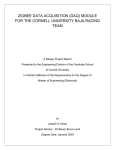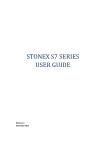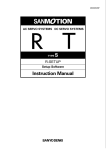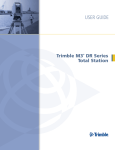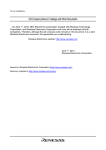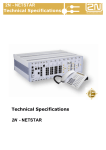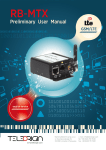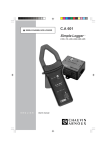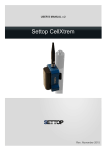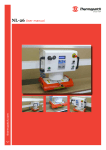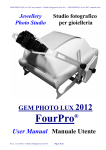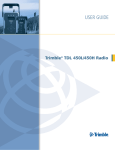Download S10 User Manual - Stonex Positioning
Transcript
User Manual STONEX S10 GNSS Receiver Author: CS (13/10/2014)-Ver.2-Rev.3 RC/EC/GQ (21/04/2015) www.stonexpositioning.com Contents 1. Introduction to Stonex S10 GNSS ............................................................................................ 2 2. S10 panel description .................................................................................................................... 3 2.1. S10 smart panel ...................................................................................................................... 3 2.2. Communications & antennas ports .................................................................................. 7 2.3. The back of the receiver ....................................................................................................... 8 3. S10 standard accessories.............................................................................................................. 9 3.1. Power supply............................................................................................................................ 9 3.2. The antennas.......................................................................................................................... 10 3.3. Cables ....................................................................................................................................... 11 3.4. Other accessories.................................................................................................................. 11 3.5. Controller STONEX S4C/H ................................................................................................. 14 4. S10 Operations ............................................................................................................................... 15 4.1. The installation of base and rover................................................................................... 15 4.2. Working mode settings ...................................................................................................... 16 4.3. How to download static data ........................................................................................... 18 5. STONEX® Web UI Applications .............................................................................................. 20 5.1. How to connect to WebUI ................................................................................................. 20 5.2. Working modes and device configuration ................................................................... 24 5.3. Rover mode ............................................................................................................................ 26 5.3.1. Option UHF .......................................................................................................... 26 5.3.2. Option Network .................................................................................................. 27 5.3.3. Option “External” ................................................................................................ 28 5.4. Base Mode .............................................................................................................................. 29 5.4.1. Option UHF .......................................................................................................... 29 5.4.2. Option Network .................................................................................................. 30 5.4.3. Option External”.................................................................................................. 31 5.5. Device configuration ........................................................................................................... 31 5.6 NMEA Settings ....................................................................................................................... 32 6. Appendix ........................................................................................................................................... 33 Appendix 1: STONEX S10/S10N electronic bubble and tilt sensor Calibration procedure ........................................................................................................................................ 33 6.1.1 E-bubble calibration ........................................................................................... 37 6.1.2 Azimuth calibration ............................................................................................. 38 6.1.3 Declination (compass) calibration .................................................................... 40 Appendix 2: Default Radio Settings ........................................................................................ 45 Appendix 3: Frequently Asked Questions............................................................................. 45 Appendix 4: Technical Specifications ..................................................................................... 47 Appendix 5: Copyrights, warranty and environmental recycling .................................. 50 Appendix 6: Safety Recommendations.................................................................................. 57 Stonex S10 GNSS Receiver – User Manual 1 1. Introduction to Stonex S10 GNSS STONEX S10 GNSS introduces revolutionary changes to the technique of surveying. Designed with the collaboration of professional Surveyors and technical engineers teams, Stonex S10 GNSS RTK technology gives the user the maximum possible reliability in every kind of environment. Compared with the previous generation GNSS receivers, the new smart Stonex S10 is introducing innovation in technology, a charming appearance design and solid magnesium alloy fuselage, incredibly small and light – less than 2Kg included the battery, resistance to impact and shock absorption function, good electromagnetic shielding and upscale appearance. Equipped with a new high accuracy integrated antenna, Stonex S10 fully supports Beidou (Compass), GPS, GLONASS, Galileo, SBAS (WAAS, EGNOS, QZSS) signals: no troubles or extra costs for new constellations hardware upgrades. The integrated TX/RX UHF radio modem supports the main standard protocols and allows Stonex S10 to be compatible with most of the existing GPS receiver. Stonex S10 is equipped with magnetic sensing system that allows to collect points quickly and with high precision, even close to walls and buildings corners. Even if you have used other GPS or GNSS products before, we recommend that you spend some time reading this manual to learn about the special features of this product. If you are not familiar with GNSS technology, we suggest you read a specific book in order to understand in a best way the contents of this manual. Any way you can ask for any technical support by sending an email to our address [email protected] or contact your local dealer. Stonex S10 GNSS Receiver – User Manual 2 2. S10 panel description STONEX S10 is a light 14 x 14 cm GNSS unit; It is equipped with an high accuracy triple frequency receiving antenna, Bluetooth© and Wi-Fi, UHF transceiver radio modem (option). The unit is divided into three parts: the upper cap, the rubber loop and the main body. The upper cap protects the integrated GNSS antenna, the rubber loop has the function of softening possible shocks or falls. In the front of the main body. On the front panel there are 2 keys and 7 indicators, on the back there are the battery house, SIM slot, SD slot and reset key. Fig. 2.1 - S10 GNSS: the front panel 2.1. S10 smart panel From the smart panel is possible to check at any time the status of the S10. The following figure shows it and the meaning of the leds. Fig. 2.2 - S10 smart panel Stonex S10 GNSS Receiver – User Manual 3 1: STATIC led (green): It switches on when the static mode is selected; it starts to blink when the receiver is recording data, with the same frequency of the sample rate. Fig. 2.3 - S10 static led 2: INTERNAL RADIO led (green): This led is green when UHF radio is selected as UHF data link. It blinks when transmitting data in base mode or receiving data in rover mode. The led is red if the current data link is external. Fig 2.4 - S10 internal radio led 3: EXTERNAL DATA LINK led (red) This led is red when external data link is selected as External data link. It starts to blink when there is data transfer ongoing. Fig 2.5 - S10 External radio led Stonex S10 GNSS Receiver – User Manual 4 4: GSM/WCDMA Network led (green): The led is on when the network module is selected as RTK data link. It starts to blink when receiving and transforming data. (download in rover mode and upload in base mode). Fig. 2.6 - S10 Network led 5: BLUETOOTH led (blue): Once S10 is connected with the controller this led will switch on. Fig 2.7 - S10 Bluetooth led 6: SATELLITE led (green): The led blinks and shows the amount of locked satellites. It starts to blink every 30 seconds for a number of times equal to the number of locked satellites. Fig. 2.8 - S10 satellite led Stonex S10 GNSS Receiver – User Manual 5 7: WiFi Led (green) WiFi is turned on when the led turns green. Fig. 2.9 - WiFi Led 7: POWER led (green and red): Power led shows 3 different status: 1. Green: power supply in good condition. 2. Red: low power (below 20%). 3. Red blinking and beeping: very low power (below 10%). Fig. 2.10 - S10 power led When the status #2 is shown (red) about 1 working hour is left. External power and internal battery share same power light. When external power is used, the led indicates external power level. When the power is below 10%, the red led will flash according to sampling interval (default is 1 seconds) and you also hear three beep every 60s. Stonex S10 GNSS Receiver – User Manual 6 2.2. Communications & antennas ports The S10 communications ports are shown in the following figures 2.11 and 2.12: the left port (5-pins LEMO) is used for external power supply and external radio, the right port (7-pins LEMO) is used for data transferring between receiver and computer or between receiver and the Controller. Figure 2.13 and 2.14 show the UHF radio port and the GPRS antenna port. Fig. 2.11 - 5-pins LEMO port Fig. 2.13 - UHF antenna port Fig. 2.12 - 7-pins LEMO port Fig 2.14 - GPRS antenna port Stonex S10 GNSS Receiver – User Manual 7 2.3. The back of the receiver Fig. 2.15 - Battery installation Fig. 2.16 - Release battery Battery installation: a quick assembly and disassembly lithium-ion battery is provided with the S10. To pull out the battery to the house, slide the battery bail to the left, as it is shown in the Figure 2.14. SIM card and SD card slots: Follow the figure to install SIM card and SD card in the slot. Reset key: Press the reset key to restart S10 receiver as the following figure shows. SIM card slot Reset button SD card slot Fig. 2.15 – SIM and SD Slots and reset button Stonex S10 GNSS Receiver – User Manual 8 3. S10 standard accessories 3.1. Power supply Batteries (P/N 30-350170) The standard configuration contains two batteries with S/N, a slot for charging the batteries (the battery charger) and one adaptor. The batteries are “LithiumIon” battery (11.1V-3400mAH; 37.7Wh), they features a very high energy-toweight ratio respect to Ni-Cd or NiMh batteries, no memory effect and slow self-discharge when it is not used. Fig. 3.1 - Lithium-Ion battery Charger + Adapter (P/N 30-350171 + 30-350072) The charger can be used for both batteries simultaneously. The lights of the charger shows if the battery is being charged (red light FULL) or if it is already charged (green light FULL). Red light POWER shows if the charger is powered on and there is also a light which turns on in case of too high temperature (red light TEMP). Fig. 3.2 - S10 charger and adaptor Stonex S10 GNSS Receiver – User Manual 9 3.2. The antennas (P/N 30-350173 - UHF, P/N 30-350174 - GPRS) UHF antenna: S10 adopts a UHF all-direction transmitting and receiving antenna. The available range are: 410-470 MHz. They are suitable for field surveying, light and durable. The gain is 2.15 dBi. Fig. 3.3 – internal radio antenna GSM antenna: S10 adopts a GSM/WCDMA/EVDO all-direction transmitting and receiving antenna with a frequency in the ranges 824-960 MHz and 1710-1880 MHz. It is suitable for field surveying, light and durable, the length is about 20 cm, the gain is around 2 dBi. Fig. 3.4 – GSM/WCDMA/EVDO antenna For S10, it is possible to use like additional accessory (not included in the standard configuration) a high-gain UHF all-directional transmitting antenna for base setup. The antenna is around 1 meter long and can be mounted on a retractable pole or a tripod for better performance. The higher the antenna is, the larger cover area does it has for the radio signal. The gain of the antenna is 5 dBi. Fig. 3.5 –External radio antenna (not in scale) Stonex S10 GNSS Receiver – User Manual 10 3.3. Cables Receivers cables (LM.GK205.ABL P/N 30-350059) This is a multi-function communication cable: it is used for connecting receiver and computer used for transferring the static data and updating the firmware. Fig. 3.6 – 7pins-USB-serial port Auxiliary cables (LM.GK185.ABL+ LM.GK224.AAZ – P/N 30-350072 + 30-350071) External power supply cables (LM.GK185.ABL+ LM.GK224.AAZ) can be ordered and used to connect an external battery (red and black clips) to the receiver (small 5-pin LEMO): Fig. 3.7 - External power supply cables 3.4. Other accessories The other accessories are: 2.45 m retractable pole, 25 cm supporting pole, two kind of brackets depending on the controller, tribrach with plummet, tripod (wood or aluminum, with quick or twist clamps), connector between receiver and tribrach, and measuring tape, quick release and mini rotary table, used for the tilt sensor calibration procedures. Stonex S10 GNSS Receiver – User Manual 11 Fig. 3.8 – 2.45m retractable pole Fig. 3.9 – 25cm supporting pole Fig. 3.10 – Bracket B1 for STONEX S4C/H Fig. 3.11 – Tribrach and adapter with optical plummet (P/N 30-010010 + 30-30-020005) Stonex S10 GNSS Receiver – User Manual 12 Fig. 3.12 – Connector between tribrach and receiver Fig. 3.13 - Measuring tape Fig. 3.14 - Quick release Stonex S10 GNSS Receiver – User Manual 13 Fig. 3.15 - Mini rotary table (P/N 30-350178) 3.5. Controller STONEX S4C/H The STONEX controller standard configuration includes only the adaptor, the battery and the USB cable. The controller is not included within the S10 accessories, it must be ordered separately. Fig. 3.16 - STONEX S4 controller Stonex S10 GNSS Receiver – User Manual 14 4. S10 Operations 4.1. The installation of base and rover Installation of Base 1) Once a tripod is open on the chosen base point, fix the tribrach and mount the receiver on it. 2) Screw the transmitting radio antenna into the port “UHF”: using the 40cm supporting pole P/N 30-350057 is suggested, in order to increase the antenna height. 3) Switch on the receiver and select the base working mode. Stonex S10 GNSS Receiver – User Manual 15 Installation of Rover 1) Mount the controller bracket on the telescopic pole and mount the controller into the bracket; screw the second S10 on the pole and mount receiving antenna into the port “UHF”. 2) Power on the receiver and select the rover working mode. 3) Switch on the controller and start the software, in order to initialize the setting of the S10. ( following the instruction manual of the field software, such as Stonex SurvCE or Stonex CUBE) For very accurate measures, we suggest to use a bipod or a tripod to support the telescopic pole in a stable way. 4.2. Working mode settings F key: Function key The FF key is used to switch the different working and data link modes (radio, network, external radio + Network) of the receiver; lightly press the F key to voice broadcast the current work status. I key: Power key Used to power on/off the receiver and as Confirm function. - Power on receiver: Press I key, all led will flash after one beep, after that receiver will switch on. Power off receiver: Long press I key, all led will flash after one beep. Press I key again to confirm, the voice prompts turn off the device. Stonex S10 GNSS Receiver – User Manual 16 Changing the working mode and data link When Stonex S10 is switched on, press F key and very quickly the Power key, if the speaker is enabled S10 broadcasts “change working” and all the leds start to blink at the same time. Then release both keys. Change working mode: Every time F key is pressed, S10 broadcasts “static”, “rover” or “base”, and the related Led is blinking (static led blinking in the first case and GSM and radio led blinking at the same time in the case of “rover” or “base”). Confirm the desired option by pressing power key. Change data link: After confirming the working mode, receiver will broadcast: “Change data link” and GSM, RADIO and power key start blinking at the same time. Every time F key is pressed, S10 broadcasts “Radio”, “network” or “external” and the corresponding led blinks, user can confirm the data link desired by pressing power key once. After confirming the working mode, receiver will broadcast “set Wi-Fi” if speaker is enable and Wi-Fi and power led will blink ad the same time. By pressing F key, user can enable or disable Wi-Fi, after choosing the option confirm by pressing power key. Self-Check: it is a procedure predisposed for verifying the correct working of the instrument device. The program is mainly to predict whether the receiver modules work normal ahead of time or not. S10 self-checking part includes GPS, WIFI, Bluetooth, radio, network and sensor; a total of six parts. - - When the receiver is on, long press and hold I key until you are prompted turn off the device and release it, then long press I key again. You will hear the beep to voice broadcast self-check and release it, then the receiver carry out self-check including GPS module, UHF module, and GPRS module. Self-check lasts typically around 1 minute. In the process of self-check, if you have failure in one module, and the voice broadcast the module does not work normal, this module led will continue to beep, until the user restart the receiver. If you have found it, please contact Stonex. Stonex S10 GNSS Receiver – User Manual 17 Successful Self-check: it means that modules work properly if every led is lit and the voice broadcast that module is succeed in self-checking (Such as “GPS OK”). The receiver will automatically reboot in 5 seconds after finish all the self-check modules and will begin to work. Note: The frequency setting of the internal UHF module is set back to factory default on self-test. Please contact your local dealer to obtain the frequency information in your country. 4.3. How to download static data Static data can be downloaded through WebUI interface or using the USB cable. For a correct connection between receiver and PC, follow the procedure described below. First turn off the receiver, then connect the cable to the communication interface of the receiver (7-pins Lemo port), then insert the USB port in the PC. The taskbar will show as follows: Fig. 4.3 - Taskbar of windows including the receiver The PC considers the receiver as a “media disk”, so open the “media disk”, and then you can get the data files in the memory. Stonex S10 GNSS Receiver – User Manual 18 Stonex S10 GNSS Receiver – User Manual 19 5. STONEX® Web UI Applications Users can manage S10 through a web interface called WebUI, it is not necessary to install software, drivers or other kinds of programs; the web interface program is built inside the receiver. From WebUI, users can set the most common operations such as working mode, UHF connection, GPRS connection, etc. These functions can be set from a PC, a smartphone or a tablet, it is only necessary a Wi-fi hardware and a web browser. Following, the principal ways to establish the connection. 5.1. How to connect to WebUI 1. The first step is to check if Wi-Fi network is available; it must be on. Search the S10 network using the connection management of the device. You can identify it by the serial number of the instrument. Then select it as the figure 5.1 shows: Figure 5.1 Once connected you have to open the browser and enter the Ip Address: http://192.168.10.1. After sending enter, you will be required to enter user and password. S10 default user and password are: User: admin Password: password Stonex S10 GNSS Receiver – User Manual 20 Figure 5.2 The user can login STONEX S10 Web UI by itself, then start for the relevant settings on the web page of S10, it can support multiple users at the same time. After a successful connection, you will see the main page as shown in the following figure: Figure 5.3 On the first window Status you will see in real time the status of the receiver. Information available are: position, satellites, current datalink, status (single, float, fix), etc. By clicking on Information window as the following figure shows, you will see further information concerning the S10. Stonex S10 GNSS Receiver – User Manual 21 Figure 5.4 You can obtain information about model, firmware version, GNSS serial, etc. You can also check for example, free memory space and battery level at any time. On Download window: Figure 5.5 You will see all the files inside memory of S10; from this menu, it is possible to download data and convert files into RINEX format. Finally, on Management, users can upgrade the firmware in an easy manner. Stonex S10 GNSS Receiver – User Manual 22 Figure 5.6 Search for the file by clicking on Search file and then click on upload file, after that you will see the following message: Figure 5.7 The receiver will reboot automatically without any action of the user. To access again it is necessary to follow the procedure indicated previously in the first step. In the registration section, user can update the registration code; If you noticed that code is going to expire or it is expired, please ask to your local dealer/agent. Stonex S10 GNSS Receiver – User Manual 23 On Security section, you can change the default password of the system authentication or disable this option. On Log section, it is possible to look or download some internal log of the receiver: APP log, OS log and kernel log. It is also possible to perform a self-check or a reset of the instrument, by clicking on the two final options of the page. 5.2. Working modes and device configuration On the right upper part of the window, you can access to the menu Settings: Figure 5.8 - Working mode and device configuration Two other menu composes it: Working mode and Device configuration. Working mode: Stonex S10 GNSS Receiver – User Manual 24 Figure 5.9 - Working mode From this window, you can change the system modem to Static, Rover or Base. On Static mode, as Figure 5.9 shows, you can enter all data required to perform a static survey: cut off angle, enable or disable some constellations, antenna height, auto record, etc. Figure 5.10 – Device configuration From this menu, users can select if enable or disable “speaker”, where to save data (internal memory or SD card). It is also possible to use advance functions like OEM connection (only for authorized dealers). Stonex S10 GNSS Receiver – User Manual 25 5.3. Rover mode To set the receiver in rover mode: Data link can be selected as (UHF, Network or External radio). 5.3.1. Option UHF From this menu is it possible to check the settings of frequencies of radio channels, together with the type of communication protocol to use (we recommend TRIMTALK® route to connect two S10) and the bandwidth of the radio channel. There are also commands to enable automatically recording the raw data, the minimum angle allowed for satellite reception, satellite constellations to be enabled. The User can also set data for advanced configuration of the radio: Width of the desired channel: 12.5 or 25 kHz. Modulation Type: Must be consistent with the protocol set. Selectable mode phase (GMSK) and frequency (4FSK). Baud rate: must be congruent with the protocol and the selected band. Selectable from a minimum of 4800 to 19200 bits CSMA: to prevent transmission if the selected channel is already occupied. Stonex S10 GNSS Receiver – User Manual 26 FEC (forward error corrector): used primarily with radio protocol Satel. Introduces the information that make more "robust" the radio message, making it less susceptible to interference. Scrambler: used mainly with Satel protocol. Area: makes the receiver fully complaint with the rules of the geographical area . Use the "SAVE" button in the lower part of the screen to save the configuration. 5.3.2. Option Network The Network option is used to set the configuration parameters of the 3G GPRS network connection, such as the type of connection you want to run (eg NTRIP, CSD). NTRIP requires to input APN, Caster Address, Port number, Mount Point, user ID and password of the provider of differential corrections. CSD option allows to enter the phone number of the SIM card inserted in the receiver used as a "base", which will connect to the rover (direct call function base-rover). This feature allows to connect the base and rover through the GSM/ UMTS data link, and it is useful when NTRIP server is not available. Auto Connect option, visible at the bottom of the page, activates the autoconnection of the modem to the UMTS/GSM network in automatic after “power on” of the instrument, without requesting any user action. Stonex S10 GNSS Receiver – User Manual 27 The other options that can be set from this menu are the same as those seen earlier. Even here, press the "SAVE" to save the configuration set. 5.3.3. Option “External” In addition to the Options “CUToff angle”, the User can enable the desired satellite constellations and the automatic recording of raw data. The baud rate of transmission between the receiver and radio is selected from the relevant box. Stonex S10 GNSS Receiver – User Manual 28 5.4. Base Mode Used to set the receiver S10 in ‘BASE’ mode. The Base can be connected to the rover through different data link. 5.4.1. Option UHF For connections through UHF radio channel. It is possible to set the automatic start of the Base (S10 Base automatically broadcasts the differential corrections without any action by the operator ), select the type of differential correction (RTCM3.x, RTCM2.x, CMR, etc). Are requested: The name of the Base (station) point the max. value of PDOP allowed to record a point inside the raw data file the geographical coordinates of the point where there is located the base (function accessible by selecting the check box "Repeat Position" the frequencies of radio channels. Finally the broadcasted power and the radio protocol to use must be selected. The following are used for advanced configuration of the radio: Power of broadcasting: it can be 0.5W or 2W. Width of the desired channel: 12.5 or 25 kHz. Modulation Type: Must be consistent with the protocol set. Selectable mode phase (GMSK) and frequency (4FSK). Stonex S10 GNSS Receiver – User Manual 29 Baud rate: must be congruent with the protocol and the selected band (Selectable from a minimum of 4800 to 19200 bit/s CSMA: to prevent transmission if the selected channel is already occupied. FEC (forward error corrector): Used primarily with radio protocol Satel. Introduces the information that make more "robust" the radio message, making it less susceptible to interference. Scrambler: used mainly with Satel protocol. Area: Makes the receiver fully complaint with the rules of the geographical area. Use the "SAVE" button in the lower part of the screen to save the configuration. 5.4.2. Option Network The Network option gives the possibility to get differential corrections through the GPRS modem; the auto-connect option to the UMTS network after completed the power on process of the receiver can be activated. NTRIP operating mode requires the same types of settings given previously for the rover mode (address of APN, Caster address, Port number, Mount Point, user ID and password of user to access the provider NTRIP). The CSD option in "Connect Mode" enables the operation of the base in direct call with the rover. In this case it must also be selected the box that enables the automatic start of the base, when completed the start-up phase. Stonex S10 GNSS Receiver – User Manual 30 5.4.3. Option External” To connect external radio. It is possible to select the baud rate of the connection between the instrument and the UHF radio. The other options were discussed previously. The SAVE button allows you to save the 'setting. 5.5. Device configuration Fig 5.10 Configuration From this menu, the User can select the language used by the WebUI, the 'time compared to the meridian GMT, toggle the "speaker", select the memory to save the raw data (internal memory or SD card), set the size of the time zone, change the refresh rate of the sensors. Other advanced functions such as direct connection to the internal modules OEM (for experts only) can be set with this menù. Use the SAVE button to save the configuration. Stonex S10 GNSS Receiver – User Manual 31 5.6 NMEA Settings Here you can activate the NMEA sentences that you want to carry out on lemo 7. You can select the refresh rate of each string on 'output lemo. There are also proprietary string where are encoded data signal to noise ratio Stonex S10 GNSS Receiver – User Manual 32 6. Appendix Appendix 1: STONEX S10/S10N electronic bubble and tilt sensor Calibration procedure One of the most innovative features of Stonex S10 GNSS is the high sensitivity tilt sensor, embedded in the receiver. This feature dramatically increase the speed of the field works and the accuracy of any measurement. Thanks to the tilt sensor the Surveyor can check the vertical position of the rover directly on the Controller’s display, and survey points even in case the position of the GNSS is not vertical and the measure must be done with the pole in tilted position. Accurate measurements require an accurate calibration of the tilt sensor: when the User needs to use the tilt sensor capabilities, the first calibration must be done, and only in case of completely different work environments a second calibration procedure is suggested (i.e., when S10/S10N are used thousands of Km far from the location of the previous calibration). The following notes help the User to perform a perfect calibration; in case of need, the User can contact the Authorized Stonex local Dealer or mail to [email protected]. What is needed to calibrate S10/S10N 2. Telescopic pole with bubble or 1. Bracket for controller) tripod with tribrach (suggested) 3. 4. Mini rotary table Controller with calibration software installed Stonex S10 GNSS Receiver – User Manual 33 Important note: avoid to calibrate S10/S10N close to strong magnetic fields environments. In order to save time, is suggested to configure S10 to get automatic FIX position before to go to the calibration location; this can be set from the WebUI, by selecting the option Auto connect: (Set yes). The Auto connection will be effective as the unit will be switched ON. Stonex S10 GNSS Receiver – User Manual 34 The calibration process consists of 3 steps, the FIX position is mandatory only for step #3, not for step #1 and #2. Pairing of the devices: before running the software, GNSS and Controller must be paired in the following way: Click on Settings.. Bluetooth.. Add new device.. Click on Done. You will Click on Next without Click on Done. You will come back to Window 3 Click on COM Ports and entering any code Select the serial number come back to Window 3 Choose a port click New Outgoing Port and click on Next Stonex S10 GNSS Receiver – User Manual 35 Click on COM Ports and Select the serial number click New Outgoing Port and click on Next Choose a port If you get the following message, select another port or delete The S10 serial number some devices. with the virtual COM Port is shown. Then click OK Starting the Calibration procedure: If Stonex Cube is present on the Controller, the icon S10 Calibration is already available on the desktop of the controller; click on it to run the calibration procedure. Stonex S10 GNSS Receiver – User Manual 36 Otherwise, the stand-alone Calibration program must be installed separately. 6.1.1 E-bubble calibration Click on Serialport Click on Horinzontal Select the port and set the As the Bluetooth led is ON baud rate to 115200. Click switch ON the receiver and on Open click Cancel Move the pole (or center the bubble on the tribrach) until the E-Bubble become green, then click on Calibration. The main menu will be displayed once again Stonex S10 GNSS Receiver – User Manual 37 6.1.2 Azimuth calibration Remove S10 from the pole and mount it on the mini rotary table. Click on Azimuth and then on Record Vertical. We suggest to high the pole at 1.80 m. As alternative, mount it on the tribrach. Slowly rotate the S10 (the rotation would be last from 1 to 2 minutes) as shown on the display; check at any time that pole bubble is centered. A green circle shows the quality of the rotation. After the rotation is completed (360°) a beep indicates that this operation is finished. Stonex S10 GNSS Receiver – User Manual 38 Remove the S10 from the mini rotary Click on Record Horizontal table and mount it on the pole. Start to slowly rotate slowly the S10 (the rotation would be last from 1 to 2 minutes) as shown on the display; check at any time that pole bubble is centered. A green circle shows the quality of the rotation. After the rotation is completed (360°) a beep indicates that this operation is finished. Stonex S10 GNSS Receiver – User Manual 39 1. Click on Calibrate… 2. …and confirm the message 3. Confirm again. When the tilt sensor facilities are not requested, the calibration process can be stopped and stored at this point. Note that the field software (if Stonex S10 compliant as CUBE and Carlson SURV CE > V.4.03) will manage the electronic bubble, not the tilted measurements! Points 6.1.1 and 6.1.2 DO NOT require the receiver in FIXED status. 6.1.3 Declination (compass) calibration The Declination operation accuracy has a great influence on the accuracy of the tilted measurements. Check the FIXED status of the receiver if not previously activated; Mount the S10 on the pole (tripod cannot be used for this step of the calibration) at a minimum height of 2 m Position MUST BE FIXED! Choose one ground point and use it for the whole operation (do not move the receiver from the same point): vertical position and 4 tilted positions, along 4 directions (East, South,West, North) Stonex S10 GNSS Receiver – User Manual 40 Click on Declination Keep the pole vertical with the bubble well centered. Then click on center point S10 automatically starts to save points (10 totally); a beep is heard when Click on Storage incline PT to continue calibration. finished the message Center point is completed displayed. Stonex S10 GNSS Receiver – User Manual 41 Next step is necessary to measure and store ten points for each geographic direction, starting from EAST, then SOUTH, WEST and NORTH. EAST DIRECTION First step: incline S10 to EAST. Tilt angle must be between 25°-30° Find the right direction using the compass of the bracket or azimuth: EAST: 90°. When both tilt angle and azimuth are correct S10 starts saving 10 point automatically. To keep the angle as much as possible close to 90° is strongly suggested. A beep is heard when finished. SOUTH DIRECTION Second step: incline S10 to the SOUTH direction. Tilt angle must be between 25°-30° South: 180°. When both tilt angle and azimuth are correct S10 starts saving 10 point automatically. To keep the angle as much as possible close to 180° is strongly suggested. A beep is heard when finished. Stonex S10 GNSS Receiver – User Manual 42 WEST DIRECTION Incline S10 to the WEST direction. Tilt angle must be between 25°-30° < West: 270°. When both tilt angle and azimuth are correct S10 starts saving 10 point automatically. To keep the angle as much as possible close to 270° is strongly suggested. A beep is heard when finished. NORTH DIRECTION Incline S10 to the NORTH direction. Tilt angle must be between 25°-30° North: 360°. When both tilt angle and azimuth are correct S10 starts saving 10 point automatically. To keep the angle as much as possible close to 360° is strongly suggested. A beep is heard when finished. Stonex S10 GNSS Receiver – User Manual 43 1. As the 4 directions are stored. Click on Correct 2. Then enter the current pole height and confirm 3. A message shows the correct bias angle. Click confirm to save the new parameters. S10 is calibrated Stonex S10 GNSS Receiver – User Manual 44 Appendix 2: Default Radio Settings S10 uses a single UHF radio to cover the different whole band 410-470 MHZ. Default values are done directly from STONEX® in according to the following tables: Rate Channels MHz 1 Channel 438.125 2 Channel 440.125 3 Channel 441.125 4 Channel 442.125 5 Channel 443.125 6 Channel 444.125 7 Channel 446.125 8 Channel 447.125 Tab. 6.1 – Internal radio default frequency (MDB) Appendix 3: Frequently Asked Questions 1. The receiver is set in static mode but it does not save data even if more than three satellites are locked. The three red lights are blinking. Solution: the internal memory of receiver is full, some files must be deleted. 2. The external and built-in power lights are blinking but no corrections is received. Solution: The activation code of the GPS expired; please contact STONEX® for a new code. 3. No success connecting the controller and the GPS via Bluetooth. Solution: the receiver has a different working mode with respect to the menu of the controller, switch the mode. If the problem persists, contact STONEX®. Stonex S10 GNSS Receiver – User Manual 45 4. The receiver is set in rover mode and GPRS/GSM data link, the SIM card is placed in its slot under the battery. However, no chances to read in the SIM card. Solution: Every SIM has its PIN number, it must be disabled. Moreover, check on a cell phone that there is enough credit on the SIM for connecting to the internet. 5. The base is transmitting a radio signal, the rover is set in rover mode and built-in radio data link, but data link light is turned off and rover does not receiver correction: the radio channels are different from Base to Rover, use the controller to select the correct radio channel on the rover. It is also important to point out that in each weather condition after coming back from the field you should keep the receiver in a warm and dry place and at the same time take out the controller and receiver from the case, in order to make them dry. Anyway, we recommend you to manage the instrument with reasonable care. Stonex S10 GNSS Receiver – User Manual 46 Appendix 4: Technical Specifications RECEIVER Channels Satellite Tracked Position Rate Signal Reacquisition RTK Signal Initialization Hot Start Initialization Reliability Internal Memory Micro SD Card 220 GPS: Simultaneous L1 C/A, L2C, L2E, L5 GLONASS: Simultaneous L1 C/A, L1P, L2 C/A, L2P, L3 SBAS: Simultaneous L1 C/A, L5 GALILEO Simultaneous E1, E5A, E5B (reserved) BeiDou 2 / COMPASS: B1, B2 Up to 50 Hz < 1 sec Typically < 10 s Typically < 15 s > 99.9 % 4 GB (Over 45 days of raw static data storage with recording sample every 1 second) Expansion slot with 4 GB internal memory (32 GB optional) POSITIONING1 HIGH PRECISION STATIC SURVEYING (Long Time Observations) Horizontal 2.5 mm + 0.3 ppm RMS Vertical 5 mm + 0.5 ppm RMS CODE DIFFERENTIAL POSITIONING 0.25 m + 1 ppm RMS Horizontal Vertical 0.45 m + 1 ppm RMS SBAS POSITIONING (Typical) Horizontal 0.5 m RMS2 Vertical 0.85 m RMS2 REAL TIME KINEMATIC (< 30 Km) – NETWORK SURVEYING3 Fixed RTK Horizontal 8 mm + 0.8 ppm RMS Fixed RTK Vertical 15 mm + 1 ppm RMS INCLINED POSITIONING (2 m POLE) 10° inclination 20 mm RMS 20° inclination 30 mm RMS 30° inclination 50 mm RMS COMMUNICATION Connectors I/O Bluetooth device Wi-Fi 7-pins Lemo and 5-pins Lemo interfaces. Multifunction cable with USB interface for PC connection 2.4 GHz class II IEEE 802.11 b/g/n Stonex S10 GNSS Receiver – User Manual 47 Web UI Reference outputs Navigation outputs To upgrade the software, manage the status and settings, data download, etc. via smart phone, tablet or other internet enabled electronic device CMR, CMR+, sCMRx, RTCM2.1, RTCM2.3, RTCM3.0, RTCM3.1 ASCII (NMEA-0183) GSV, AVR, RMC, HDT, VGK, VHD, ROT, GGK, GSA, ZDA, VTG, GST, PJT, PJK, BPQ, GLL, GRS, GBS INTEGRATED GNSS ANTENNA INTERNAL RADIO Frequency Range Channel Spacing Emitting Power Maximum Range Protocol 403 - 473 MHz 12.5 KHz / 25 KHz 0.5/2 W 3-4 Km in urban environment, 5-6 Km with optimal conditions4 Transparent EOT/EOC/FST, SATEL, South, TRIMTALK II/IIe, TRIMMARK 3, TRIMTALK 450S WIRELESS MODULE Band Output Power GSM/GPRS/EDGE: 850/900/1800/1900 MHz WCDMA/HSDPA: 850/1900/2100 MHz GSM850, EGSM900: 33 dBm(2W) GSM1800, PCS1900: 30 dBm(1W) WCDMA: 24 dBm POWER SUPPLY Battery Voltage Working Time in Static Mode (GPS+GLONASS) Working Time in GSM RTK with Cable Connection (GPS+GLONASS) Working Time in Wireless Network RTK with Bluetooth Connection (GPS+GLONASS) Charge Time (2 batteries) Rechargeable and replaceable 11.1 V – 3400 mAh -37.74 Wh intelligent lithium battery 9 to 22 V DC external power input with over-voltage protection (5 pins Lemo) 12 hours 6.5 hours 4 hours Typically 7 hours Stonex S10 GNSS Receiver – User Manual 48 Power Consumption Remaining Time Battery Light Blinking <6W 1 hour PHYSICAL SPECIFICATION Weight Operating Temperature Storage Temperature Operating Temperature with UHF Radio Waterproof/Dustproof Vibration Shock Resistance Winter Grade Option 1.37 Kg (with internal battery, radio standard UHF antenna) -30°C to 65°C (-22°F to 149°F) -40°C to 85°C (-40°F to 185°F) -30°C to 50°C IP67. Protected from temporary immersion to depth of 1 meter and from 100% humidity Vibration resistant Designed to endure to a 2 m pole drop on concrete floor with no damage Designed to endure a 1 m free drop on hardwood floor with no damage Operating at -40°C (-40°F) High accuracy four constellation micro-strip antenna with internal multipath suppression board Specifications subject to change without notice. 1. 2. 3. 4. Accuracy and reliability are generally subject to satellite geometry (DOPs), multipath, atmospheric conditions and obstructions. In static mode they are subject even to occupation times: the longer is the Baseline, the longer must be the occupation time. Depends on SBAS system performance. Network RTK precisions depends on the network performances and are referenced to the closest physical base station. Varies with the operating environment and with electromagnetic pollution. Stonex S10 GNSS Receiver – User Manual 49 Appendix 5: Copyrights, warranty and environmental recycling Copyrights and trademarks © 2014, STONEX® Limited. All rights reserved. STONEX®, the STONEX® logo, and S10 GNSS receiver are trademarks of STONEX® Limited. STONEX® Assistant, STONEX® GPS Processor and STONEX® Surpad are trademarks of STONEX® Limited. Bluetooth is a trademark owned by Bluetooth SIG, Inc. and licensed to STONEX®. All other trademarks are the property of their respective owners. Copyrights, warranty and environmental recycling Version 2014 The terms and conditions of this Limited Warranty constitute the complete and exclusive warranty agreement between The Customer or Dealer and STONEX® for the Product and supersede any prior agreement or representation made in any STONEX® sales document or advice that may be provided to Customer by any STONEX® representative in connection with Customer’s purchase of the Product. No change to the conditions of this Limited Warranty is valid unless it is made in written form and signed by an authorized STONEX® supervisor. STONEX ® warrants that its products: (1) Be free from defects in materials or workmanship for generally 2 years. a) Accessories or specific parts for which different limited warranty period shall apply. (2) Have been tested/calibrated in proper working status prior to shipment. The warranty period starts from date of first sale of the instruments. At its sole discretion, under the warranty period, STONEX® will repair the product or send parts for replacement at its expense. Stonex S10 GNSS Receiver – User Manual 50 STONEX® agrees to repair or replace the defected instrument within thirty (30) days only if STONEX® recognizes that the defects of the instrument are not caused by human factors or no obvious damage to its surface is visible. STONEX® warrants any new replaced parts or products are warranted to be free from defects in materials and workmanship for thirty (30) days or for the remainder of the Limited Warranty Period of the Product in which they are installed, whichever is longer. Faulty Parts or Products replaced under this Limited Warranty shall become property of STONEX®. All products that have to be repaired have to be returned to our technical representative office location via any delivery company the customer prefers, nevertheless STONEX® is not accountable for the unlikely event that the Products gets lost in transit. Any damage inflicted by the customer or by third party after the products has been delivered to the customer is excluded from the limited warranty as well any damage arising from an improper use, from any action or use not provided for in the enclosed user guides and/or manuals. Shipping policy The Customer or the dealer is required to pay for the charges for shipping of fault part or instruments to STONEX® representative office and STONEX® is providing the shipping for return. Dealers need to follow STONEX® repair/service procedure (see appendix 6) to achieve a better and prompt service result. Return policy Dead On Arrival instruments All returned products have to be shipped to STONEX® representative office. The original Purchaser has a period of seven (7) days starting from date of purchasing to signal the existence of a defect in the instrument for a full refund (less shipping and handling), provided the merchandise is in new, resalable condition and returned in the original, undamaged packaging. Customer has to pay for both the return and the original freight fees, regardless of the original freight paid by the Company. All warranty books, instruction manuals, parts and accessories must be included as well as the original box in which the item was shipped. We recommend to place the original carton inside another box, to avoid any additional damage to the carton itself. In some cases, returns of special items will require a re-stock fee. Acceptance of returned merchandise is final only after inspection by STONEX®. Stonex S10 GNSS Receiver – User Manual 51 Above terms and policies shall apply as for hardware. Dealers need to follow STONEX® repair/service procedure (see appendix 4) to achieve a better and prompt service result. Firmware/Software warranty Stonex® doesn’t warrant that operation of Firmware/Software on any instruments will be uninterrupted or error-free, or that functions contained in Firmware/Software will operate to meet your requirements. Stonex® will forward the Software/Firmware Fix to the dealer or customer. Firmware/software Fix means an error correction or other update created to fix a previous firmware version that substantially doesn’t conform to the instruments specification. Over Warranty repair(s) policy Customer shall pay the standard repair fees for any service (whether part replacement or repairs) and performed by STONEX® under request and explicit authorization of the customer itself. In this case the customer is charged for return shipment’s fees as well. Disclaimer and Limitation of Remedy All other express and implied warranties for this product, including the implied warranties of merchantability and fitness for a particular purpose and/or noninfringement of any third party’s rights, are hereby disclaimed. Stonex® expressly disclaims all warranties not stated in this limited warranty. Any implied warranties that may be imposed by law are limited in duration to the term of this limited warranty. Some jurisdictions do not allow the exclusion of implied warranties or limitations on how long an implied warranty lasts, so the above exclusions or limitations may not apply to customer. Customer must read and follow all set-up and usage instructions in the applicable user guides and/or manuals enclosed. If customer fails to do so, this product may not function properly and may be damaged. Customer may lose data or sustain personal injuries. Stonex®, its affiliates and suppliers do not warrant that operation of this product will be uninterrupted or error free; as do all electronics at times. If this product fails to work as Stonex S10 GNSS Receiver – User Manual 52 warranted above, customer’s sole and exclusive remedy shall be repair or replacement. In no event will Stonex®, its affiliates or suppliers be liable to customer or any third party for any damage in excess of the purchase price of the product. This limitation applies to damages of any kind whatsoever including (1) damage to, or loss or corruption of, customer’s records, programs, data or removable storage media, or (2) any direct or indirect damages, lost profits, lost savings or other special, incidental, exemplary or consequential damages, whether for breach of warranty, contract, tort or otherwise, or whether arising out of the use of or inability to use the product and/or the enclosed user guides and/or manuals, even if Stonex®, or an authorized Stonex® representative, authorized service provider or reseller has been advised of the possibility of such damages or of any claim by any other party. Some jurisdictions do not allow the exclusion or limitation of incidental or consequential damages for some products, so the exclusions or limitations may not apply to customer. This limited warranty gives customer specific legal rights, and customer may also have other rights which vary from country/state/jurisdiction to country/state. Instruments Two (2) years on STONEX® Products: GPS receiver S10 GNSS Series Stonex S10 GNSS Receiver – User Manual 53 Accessories Accessories & Specific Parts Warranty For Accessories provided by Stonex® with the instruments S10 GNSS the following general warranty time is for reference: Batteries 7 months Battery chargers 7 months Adapters for battery chargers, Cables, Tribrach, Pole, Antennas 2 years Restriction for GPS Boards For GPS receiving boards (Trimble) used on S10 series of GPS receivers, Stonex® provides warranty time for one (1) year. Service Procedure Repair/Service procedure for dealers: (1) S/N of the instrument and a detailed description of the defect (sometimes pictures or video) will be required to indicate the cause and problem. (2) If dealer wants to repair an instrument under warranty period on their site: 1) If dealers don’t have the part in stock they have to send an official order to STONEX® and pay for it and so STONEX® will send the new part to them so they can repair the instrument. 2) When the repair is over, the dealer has to fill the “Spare Part Refund” module and send it to the dedicated mail address. 3) Wait for STONEX®’s authorization SPR no; 4)When dealer receive the SPR authorization no they can send back to STONEX® appointed office the broken part with attached the SPR module; 5) When STONEX® receives the broken part STONEX® shall verify it and if everything is ok the cost of the part shall be refund ( refund will be done only after check of the failure part and final approval of STONEX®). (3) If the instrument needs to be sent back to STONEX® for repair/replacement, dealer/customer has to send to STONEX® a “Returned Merchandise Authorization (RMA)” before they send back the fault instrument. Stonex S10 GNSS Receiver – User Manual 54 STONEX® shall, at its sole discretion, decide on the place of performance for work under warranty. Environmental recycling The cardboard box, the plastic in the package and the various parts of this product have to be recycled and disposed of in accordance with the current legislation of your Country. For Countries in the European Union (EU) The disposal of electric and electronic device as solid urban waste is strictly prohibited: they must be collected separately. Contact Local Authorities to obtain practical information about correct handling of the waste, location and times of waste collection centres. When you buy a new device of ours, you can give back to our dealer a used similar device. The dumping of these devices at unequipped or unauthorized places may have hazardous effects on health and environment. The crossed dustbin symbol means that the device must be taken to authorized collection centers and must be handled separately from solid urban waste. For Countries outside European Union (EU) The treatment, recycling, collection and disposal of electric and electronic devices may vary in accordance with the laws in force in the Country in question. This equipment has been tested and found to comply with the limits for a Class B digital device, pursuant to Part 15 of the FCC Rules. These limits are designed to provide reasonable protection against harmful interference in a residential installation. This equipment generates, uses and can radiate radio frequency energy and, if not installed and used in accordance with the instructions, may cause harmful interference to radio communications. However, there is no guarantee that interference will not occur in a particular installation. Stonex S10 GNSS Receiver – User Manual 55 If this equipment does cause harmful interference to radio or television reception, which can be determined by turning the equipment off and on, the user is encouraged to try to correct the interference by one or more of the following measures: Reorient or relocate the receiving antenna. Increase the separation between the equipment and receiver. Connect the equipment into an outlet on a circuit different from that to which the receiver is connected. Consult the dealer or an experienced radio/TV technician for help. Stonex S10 GNSS Receiver – User Manual 56 Appendix 6: Safety Recommendations Warnings and Cautions An absence of specific alerts does not mean that there are no safety risks involved in the use of this equipment. Always follow the instructions that accompany a Warning or Caution, reported in this. This information are intended to minimize the risk of personal injury and/or damage to propriety. In particular, observe safety instructions that are presented in the following form: WARNING - A Warning alerts about risk for health and/or damage to the propriety. A warning identifies the nature of the risk and the extent the possible injury and/or damage. It also describes how to protect yourself and/or the equipment from this risk. CAUTION - A Caution alerts about a possible risk of damage to the equipment and/or loss of data, but no risk for human safety. Wireless Module Approval The receivers uses internal wireless modules or can be connected to an external data communications UHF radio. Regulations regarding the use of the radio-modems vary greatly from country to country. In some countries, the unit can be used without obtaining an approval license. Other countries require specific approval or auto certification by the set maker. Before using this instrument , check if authorization to operate the receiver is required in your country. It is the responsibility of the importer to verify if it is necessary a certification or license for the equipment in the country of use. Instrument Approval Covers technical features of the equipment relatives to electromagnetic emissions that can cause interference and disturbances to other instruments (note like emc compatibility) or generate not correct functionalities of the instrument itself. Approval is granted by the manufacturer of the equipment. Some countries have unique technical requirements for operation in particular frequency bands. To comply with those requirements, Stonex srl may modified the equipment to be subjected to grant. Stonex S10 GNSS Receiver – User Manual 57 Unauthorized modification of the units voids already got approvals, the warranty time and the operational licenses of the instrument. UHF 410-470 MHz Data transceiver General Antenna Installation Warning 1. All antenna installation and servicing is to be performed by qualified technical personnel only. When servicing the antenna, or working at distances closer than those listed below, ensure the transmitter has been disabled. 2. Typically, the antenna connected to the transmitter is a directional (high gain) antenna, fixed-mounted on the side or top of a building, or on a tower. Depending upon the application and the gain of the antenna, the total composite power could exceed 90 watts ERP. The antenna location should be such that only qualified technical personnel can access it, and that under normal operating conditions no other person can touch the antenna or approach within 0.6 meters of the antenna. You can see below a table showing the Antenna Gain versus Recommended Safety Distance: Antenna Gain Minimum RF safety distance 0-5 dBi 5-10 dBi 10-16.5 dBi 0.6 meters 1.06 meters 2.3 meters For USA: The FCC has adopted a safety standard for human exposure to radio frequency electromagnetic energy. Proper use of this radio modem results in exposure below government limits. The following precautions are recommended: DO NOT operate the transmitter when someone is located less than 20 cm (7.8 inches) of the antenna. DO NOT collocate (place within 20 cm) the radio antenna with any other transmitting instruments. Stonex S10 GNSS Receiver – User Manual 58 DO NOT operate the transmitter unless all RF connectors are secure and any open connectors are properly terminated. DO NOT operate the equipment near electrical blasting caps or in an explosive atmosphere. All equipment must be properly used according to the installation instructions for safe operation. All equipment should be repaired and calibrated only by a qualified technician. GPRS/GSM/UMTS modem Be sure the use of this product is allowed in the country and in the environment required. The use of this product may be dangerous and has to be avoided in the following areas: • Where it can interfere with other electronic devices in environments such as hospitals, airports, aircrafts, etc. • Where there is risk of explosion such as gasoline stations, oil refineries, etc. It is responsibility of the user to enforce the country regulation and the specific environment regulation. Do not disassemble the product; any mark of tampering will compromise the warranty validity. Cautions have to be taken for the SIM, checking carefully the instruction for its use. Do not insert or remove the SIM when the product is in switched on. Every module has to be equipped with a proper antenna with specific characteristics. The antenna has to be installed with care in order to avoid any interference with other electronic devices and has to guarantee a minimum distance from the body (20 cm). For Europe The European Community provides some Directives for the electronic equipments introduced on the market. Stonex S10 GNSS Receiver – User Manual 59 All the relevant information’s are available on the European Community website: http://ec.europa.eu/enterprise/sectors/rtte/documents/ The text of the Directive 99/05 regarding telecommunication equipments is available, while the applicable Directives (Low Voltage and EMC) are available at: http://ec.europa.eu/enterprise/sectors/electrical FOR USA For your own safety, and in terms of the RF Exposure requirements of the FCC always observe the precautions listed here. • Maintain a minimum separation distance of 20 cm (7.8 inches) between yourself and the radiating antenna. • Do not collocate (place within 20 cm) the radio antenna with any other transmitting device. Bluetooth/WiFi radio Module The radiated output power of the internal Bluetooth module of this equipment is far below the FCC and EU radio frequency exposure limits. In any case, be sure to use the equipment with the radio far at least 20 cm from the human body. The Bluetooth module match the guidelines found in radio frequency “safety standards and recommendations “published by Scientific organizations. Stonex srl therefore believes the internal wireless radio is safe for use by end users. The level of energy emitted is far less than the electromagnetic energy emitted by wireless devices such as UMTS phones. However, the use of Bluetooth/WiFi may be restricted in some special situations or place , like aircraft , hospital ,etc. If you are unsure of existence of restrictions, you should ask for authorization before switching on the Bluetooth radio. Raccomandation for installing antennas for internal radios An absence of specific alerts does not mean that there are no safety risks involved in the use of this equipment. Stonex S10 GNSS Receiver – User Manual 60 Always follow the instructions that accompany a Warning or Caution, reported in this. This information are intended to minimize the risk of personal injury and/or damage to propriety. In particular, observe safety instructions that are presented in the following form: CAUTION For your own safety, and to match the RF Exposure requirements of the FCC, always observe these precautions: Always maintain a minimum separation distance of 20 cm (7.8 inches) between yourself and the radiating antenna. Do not collocate (place within 20cm) the radio antenna with any other transmitting device. Do not switch on the GSM or UHF module without the antenna mounted to the external connector. UHF Antennas having a gain greater than 5 dBi, are strictly prohibited for use with this device. The required antenna impedance must be 50 ohms. GSM/UMTS Antennas having a gain greater than 3 dBi (for mobile applications) are strictly prohibited for use with this device. To reduce potential radio interference to other users, the antenna type and its gain should be so chosen that the equivalent isotropical radiated power (e.i.r.p.) is not more than the one necessary to get successful connection. Stonex S10 GNSS Receiver – User Manual 61 Rechargeable Lithium-ion batteries These receivers use a rechargeable Lithium-ion battery. WARNING - Do not creates damage at the rechargeable Lithium-ion battery. A damaged battery can cause an explosion, with risk or fire, and can result in personal injury and/or property damage. To prevent injury or damage: – Do not use or charge the battery if it appears to be damaged. Signs of damage are discoloration, warping, leaks of liquids. – Do not expose the battery to fire, high temperature, or direct strong sunlight. – Do not introduce the battery in water or liquid substance , in general. – Do not use or store the battery in very hot ambient. – Do not drop or puncture the battery. – Do not open the battery and do not put in short-circuit its electrical contacts. WARNING - Avoid direct contact with the rechargeable Lithium-ion battery if it appears damage. Battery liquids are corrosive and, and contact with it can result in personal injury or damage to proprieties. To prevent injury or damage: – If the battery leaks, avoid contact with the battery fluid. – If battery fluid gets into your eyes, immediately rinse your eyes with clean water and seek medical attention. Do not rub your eyes! – If battery fluid gets onto your skin or clothing, immediately use clean water to wash off the battery fluid. Stonex S10 GNSS Receiver – User Manual 62 STONEX® SRL Via Cimabue, 39 - 20851 Lissone (MB) Tel : +390392783008 ; +390392785575 | Fax :+390392789576 Stonex S10 GNSS Receiver – User Manual 63 www.stonexpositioning.com | [email protected]
































































